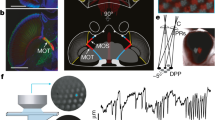Abstract
THE muscles associated with the vertebrate eye are well known, comprising those responsible for eye movements and the muscles within the eye controlling the iris and lens. The compound eyes of insects form part of the head capsule, and movements of the eye as a whole seem to demand that the whole head be moved as in the peering movements of young locusts1. There is only one little-known reference to a muscle within the compound eye itself, in the blowfly Calliphora2. Lowne called it a “ciliary muscle”, but only noted its outer attachment. Fig. 1a shows that the muscle is attached externally to the medial border of the membrane at the base of the receptor layer, and internally to the tentorium (the internal supporting structure of the insect head). It is supplied by a fine branch of the antennal nerve. We have found comparable muscles in other Diptera, for example, syrphids, tipulids and culicids.
This is a preview of subscription content, access via your institution
Access options
Subscribe to this journal
Receive 51 print issues and online access
$199.00 per year
only $3.90 per issue
Buy this article
- Purchase on Springer Link
- Instant access to full article PDF
Prices may be subject to local taxes which are calculated during checkout
Similar content being viewed by others
References
Wallace, G. K., J. Exp. Biol., 36, 512 (1959).
Lowne, B. T., The Anatomy, Physiology, Morphology and Development of the Blow-fly (Calliphora erythrocephala) (Porter, R. H., London, 1892).
Leutscher-Hazelhoff, J. T., and Kuiper, J. W., The Functional Organization of the Compound Eye (edit. by Bernhard, C. G.), 483 (Pergamon, 1966).
Gemperlein, R., and Jarvilehto, M., Z. Vergl. Physiol., 65, 445 (1969).
Lüdtke, H., Z. Vergl. Physiol., 35, 129 (1953).
Sato, S., Kato, M., and Toriumi, M., Sci. Rep. Tohoku. Univ., Ser. 4, 91 (1957).
Sotavalta, O., Tuurala, O., and Oura, A., Ann. Acad. Sci. Fenn., A, IV, 62 (1962).
Tuurala, O., Ann. Entomol. Fenn., 29, 209 (1963).
Walcott, B., Nature, 223, 971 (1969).
Land, M. F., J. Exp. Biol., 51, 471 (1969).
Gregory, R. L., Ross, H. E., and Moray, N., Nature, 201, 1166 (1964).
Ditchburn, R. W., and Ginsborg, B. L., Nature, 170, 36 (1952).
Burrows, M., and Horridge, G. A., J. Exp. Biol., 49, 223 (1968).
Author information
Authors and Affiliations
Rights and permissions
About this article
Cite this article
BURTT, E., PATTERSON, J. Internal Muscle in the Eye of an Insect. Nature 228, 183–184 (1970). https://doi.org/10.1038/228183a0
Received:
Revised:
Issue Date:
DOI: https://doi.org/10.1038/228183a0
Comments
By submitting a comment you agree to abide by our Terms and Community Guidelines. If you find something abusive or that does not comply with our terms or guidelines please flag it as inappropriate.



